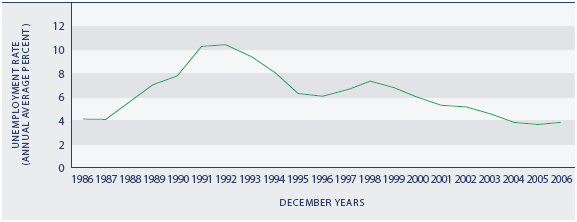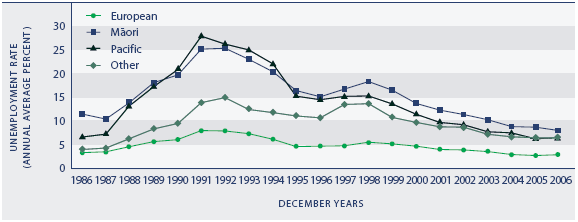Unemployment
Definition
The unemployment rate is the number of people aged 15 years and over who are not employed and who are actively seeking and available for paid work, expressed as a percentage of the total labour force.
The labour force is defined as the population aged 15 years and over who are either employed or unemployed.
Relevance
This is a key indicator of labour market outcomes and the lack of access to employment. The unemployment rate is an important reflection of overall economic conditions and gives some sense of the ease with which people are able to move into employment.
Current level and trends
In 2006, 3.8 percent of the labour force (or 82,600 people) were unemployed and actively seeking work. The unemployment rate has declined steadily since 1998 and is considerably lower than the peak rate of 10.4 percent in 1992 (176,000 people unemployed). The 2006 unemployment rate was lower than the rate of 4.1 percent in 1986 when records began (70,000 people unemployed).
In 2006, 20 percent of the surveyed unemployed who specified their duration of unemployment had been unemployed for a continuous period of six months or more, a decline from 22 percent in 2005. The 2006 level of long-term unemployment was below that recorded in 1986 (23 percent) and substantially lower than the peak of 53 percent in 1992.
Figure PW1.1 Unemployment rate, 1986–2006

Source: Statistics New Zealand, Household Labour Force Survey
Age and sex differences
Unemployment rates among different age groups have followed similar trends. The unemployment rate for 15–24 year olds has, in every year, been greater than that for older age groups because those with fewer skills and less experience take longer to find suitable employment. The unemployment rate is not specifically a measure of youth who are inactive or at risk of poor transitions into work or higher education. Unemployment rates were higher for males than females in the peak years of unemployment but, since 2002, females have had slightly higher unemployment rates than males.
Table PW1.1 Unemployment rates (%), by age and sex, selected years, 1986–2006
| Year |
15–24 |
25–44 |
45–64 |
Total 15+ |
Males |
Females |
| 1986 |
7.9 |
3.1 |
1.8 |
4.1 |
3.6 |
4.8 |
| 1991 |
18.8 |
8.8 |
6.1 |
10.3 |
10.9 |
9.6 |
| 1996 |
11.8 |
5.2 |
3.9 |
6.1 |
6.1 |
6.1 |
| 2001 |
11.8 |
4.5 |
3.4 |
5.3 |
5.3 |
5.3 |
| 2005 |
9.4 |
2.9 |
2.1 |
3.7 |
3.4 |
4.0 |
| 2006 |
9.6 |
2.9 |
2.0 |
3.8 |
3.5 |
4.1 |
Source: Statistics New Zealand, Household Labour Force Survey
Note: Average for December years
Ethnic differences
The Māori unemployment rate rose from 11.3 percent in 1986 to a peak of 25.4 percent in 1992. It had fallen to 7.9 percent by 2006, the lowest rate since the survey began. Between 1986 and 1991, the unemployment rate for Pacific peoples rose from 6.6 percent to 28 percent, the highest rate for any ethnic group. Since the early-1990s, the Pacific peoples’ unemployment rate has declined more than that of Māori and was 6.4 percent in 2006. This was lower than the rate in 1986.
The unemployment rate is lowest among people of European ethnicity. Their unemployment rate rose from 3.3 percent in 1986 to a peak of 7.9 percent in 1992 and had dropped to 2.7 percent by 2006. The unemployment rate of the Other ethnic group category (made up mainly of Asians, but includes many recent migrants) increased from 3.7 percent in 1986 to 14.8 percent in 1992, and was still relatively high at 6.2 percent in 2006.
Figure PW1.2 Unemployment rate, by ethnic group, 1986–2006

Source: Statistics New Zealand, Household Labour Force Survey
Note: Other includes Asian
International comparison
In 2006, out of 27 OECD countries, New Zealand ranked third (after South Korea and Norway) with a standardised unemployment rate of 3.8 percent, compared with the OECD average of 6.0 percent. Since the mid-1980s, New Zealand's unemployment rate relative to other OECD countries has ranged from one of the lowest (fifth in 1986 with a rate of 4.1 percent) to one of the highest (17th in 1992 with a rate of 10.3 percent). The New Zealand unemployment rate in 2006 was lower than those of Japan (4.1 percent), the United States (4.6 percent), Australia (4.9 percent), the United Kingdom (5.3 percent), and Canada (6.3 percent).48 In 2005, New Zealand ranked fifth in terms of the proportion of the unemployed who had been unemployed for six months or longer.49
|


